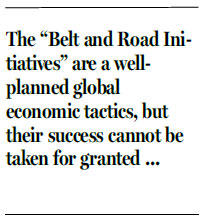Pragmatism can lead Silk Roads to success
By Huang Yiping (China Daily) Updated: 2015-02-25 08:24
Unlike the "go west" policy in which the central government invested the funds with the local governments trying to get optimum returns on them, China should not be the only country to fund all the "Belt and Road" projects. Other countries and regions involved should make their part of the contributions and cooperate with each other to make the initiatives a success. Indiscriminate investment is unlikely to yield the expected benefits; instead, they could invite criticism from the international community.
China should also avoid going the Japan way. The large-scale overseas investment drive Japan launched in the 1980s - thanks to the yen's appreciation and rising labor costs - sparked worldwide worries over whether Japan would "buy" the entire world. In the end, the returns on many of Japan's overseas projects were below expectations.
True, China is the world's second-largest source of outbound direct investment. But then more than half of its overseas investment projects are not profitable. Given this fact, blindly pushing domestic enterprises to invest overseas under the "Belt and Road Initiatives" is unlikely to produce satisfactory results.
The "Belt and Road Initiatives" are a well-planned global economic tactics, but their success cannot be taken for granted in the situations prevailing at home and abroad. So, China has to play a guiding role in their implementation and refrain from excessive intervention.
Infrastructure projects in partner countries should be carried out under a global cooperation mechanism that guarantees good returns on investments. And domestic enterprises should establish a decision-making mechanism that can hold decision-makers accountable for their wrong decisions.
Therefore, the two prime recipes of the initiatives' success are a cautious approach and proper implementation.
The author is deputy-dean of the National School of Development, Peking University.

I’ve lived in China for quite a considerable time including my graduate school years, travelled and worked in a few cities and still choose my destination taking into consideration the density of smog or PM2.5 particulate matter in the region.











